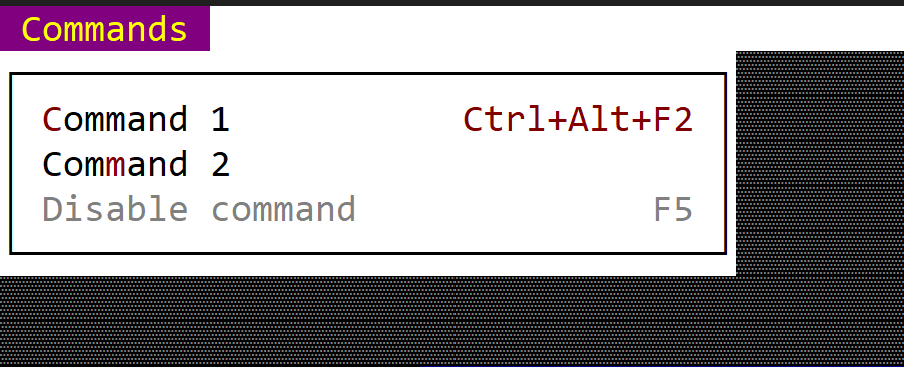Command (menu item)
A command menu item is an equivalent of a button but for menus.

You can create it using either menu::Command::new(...) method or via the menuitem! macro.
let cmd = menu::Command::new("Content", Key::new(KeyCode::F1,KeyModifier::None), <module>::Command::Content);
or
let cmd = menu::Command::new("Content", key!("F1"), <module>::Command::Content);
or
let cmd = menuitem!("Content,F1,'<module>::Command::Content'");
or
let cmd = menuitem!("Content,F1,cmd:Content,class:<class-name>");
Macro build
The following parameters are accepted by menuitem! when building a command menu item:
| Parameter name | Type | Positional parameter | Purpose |
|---|---|---|---|
text or caption | String | Yes (first postional parameter) | The caption (text) of the command. If the caption contains the special character & the next character after that will act as a short key (meaning that pressing that character while that menu is opened is equivalent to clicking on that item) |
key or shortcut or shortcutket | String | Yes (second positional parameter) | The shortcut associated with the command. If not specified it will be considered Key::None |
cmd or cmd-id or command or command-id | String | Yes (third positional parameter) | The associated command id for this item |
type | String | No | The type of the item (for a command item if this filed is being specified its value must be command) |
class | String | No | The name of the class where the menu is being implemented |
enable or enabled | Bool | No | Use this to disable or enable a menu item |
Events
To intercept events this item, the following trait and method have to be implemented to the Window that processes the event loop:
trait MenuEvents {
fn on_command(&mut self, menu: Handle<Menu>, item: Handle<menu::Command>, command: <module>::Commands) {
// add logic here
}
}
Methods
The following methods are availble for a menu::Command object:
| Method | Purpose |
|---|---|
set_caption(...) | Set the new caption for the item. If the string provided contains the special character &, this method also sets the hotkey associated with an item. If the string provided does not contain the & character, this method will clear the current hotkey (if any). |
caption() | Returns the current caption of an item |
set_enables(...) | Enables or disables current item |
is_enabled() | true if the item is enables, false otherwise |
set_shortcut(...) | Sets a new shortcut for the current item |
shortcut() | Returns the shortcut for the current item |
Example
The following code creates a menu with 3 menu items (of type command). Notice that we had to initialize the application with support for menus.
use appcui::prelude::*;
#[Window(events = MenuEvents+AppBarEvents, commands=Cmd1+Cmd2+Cmd3)]
struct MyWin {
m_commands: Handle<MenuButton>,
}
impl MyWin {
fn new() -> Self {
let mut w = MyWin {
base: window!("Test,a:c,w:40,h:8"),
m_commands: Handle::None,
};
let mut m = Menu::new();
m.add(menu::Command::new("Command-1", Key::None, mywin::Commands::Cmd1));
m.add(menu::Command::new("Command-2", Key::None, mywin::Commands::Cmd2));
m.add(menuitem!("Command-3,F1,cmd:Cmd3,class:MyWin"));
w.m_commands = w.appbar().add(MenuButton::new("Commands", m, 0, Side::Left));
w
}
}
impl AppBarEvents for MyWin {
fn on_update(&self, appbar: &mut AppBar) {
appbar.show(self.m_commands);
}
}
impl MenuEvents for MyWin {
fn on_command(&mut self, menu: Handle<Menu>, item: Handle<menu::Command>, command: mywin::Commands) {
match command {
mywin::Commands::Cmd1 => { /* do something with command 1 */ },
mywin::Commands::Cmd2 => { /* do something with command 2 */ },
mywin::Commands::Cmd3 => { /* do something with command 3 */ },
}
}
}
fn main() -> Result<(), appcui::system::Error> {
let mut a = App::new().app_bar().build()?;
a.add_window(MyWin::new());
a.run();
Ok(())
}